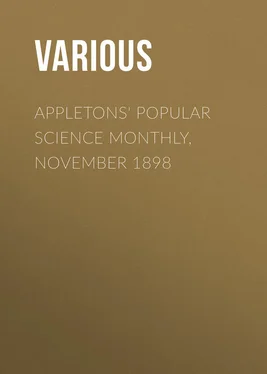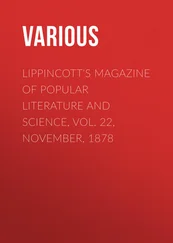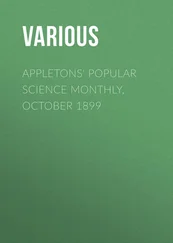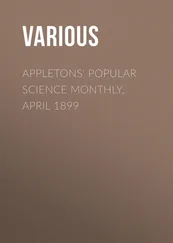Various - Appletons' Popular Science Monthly, November 1898
Здесь есть возможность читать онлайн «Various - Appletons' Popular Science Monthly, November 1898» — ознакомительный отрывок электронной книги совершенно бесплатно, а после прочтения отрывка купить полную версию. В некоторых случаях можно слушать аудио, скачать через торрент в формате fb2 и присутствует краткое содержание. Издательство: Иностранный паблик, Жанр: periodic, foreign_edu, на английском языке. Описание произведения, (предисловие) а так же отзывы посетителей доступны на портале библиотеки ЛибКат.
- Название:Appletons' Popular Science Monthly, November 1898
- Автор:
- Издательство:Иностранный паблик
- Жанр:
- Год:неизвестен
- ISBN:нет данных
- Рейтинг книги:5 / 5. Голосов: 1
-
Избранное:Добавить в избранное
- Отзывы:
-
Ваша оценка:
- 100
- 1
- 2
- 3
- 4
- 5
Appletons' Popular Science Monthly, November 1898: краткое содержание, описание и аннотация
Предлагаем к чтению аннотацию, описание, краткое содержание или предисловие (зависит от того, что написал сам автор книги «Appletons' Popular Science Monthly, November 1898»). Если вы не нашли необходимую информацию о книге — напишите в комментариях, мы постараемся отыскать её.
Appletons' Popular Science Monthly, November 1898 — читать онлайн ознакомительный отрывок
Ниже представлен текст книги, разбитый по страницам. Система сохранения места последней прочитанной страницы, позволяет с удобством читать онлайн бесплатно книгу «Appletons' Popular Science Monthly, November 1898», без необходимости каждый раз заново искать на чём Вы остановились. Поставьте закладку, и сможете в любой момент перейти на страницу, на которой закончили чтение.
Интервал:
Закладка:
The United States has conducted experiments or instituted inquiries in the fiber interest at various times in the last fifty years, but it is only since 1890 that an office of practical experiment and inquiry has been established by the United States Department of Agriculture, that has been continuous through a term of years.
A Cotton Field in Mississippi.
In the present work the efforts of the Government have been mainly directed in the line of collecting and disseminating authoritative information relating to all branches of the industry, in importing proper seed for experimental cultivation, and in directing experiments, either on its own account or in co-operation with State and even private interests. The testing of new labor-saving machinery has also come within its province.
The subject in its details will be better understood by considering the list of the more important commercial fibers known to our market. The list is not a long one, for it barely reaches a total of fifteen species. The fibers of the first rank are the spinning fibers – namely, cotton, flax, hemp, jute; of the second rank, or cordage fibers, Sisal, Manila, Sunn and Mauritius hemps, and New Zealand flax; and of the third rank, Tampico, or ixtle, African fiber or palmetto, coir or cocoanut, piassaba, Mexican whisk, raffia, and Spanish moss, which are used in brush manufacture, in upholstery, and for other rough manufactures. Of these fifteen forms, only cotton, hemp, palmetto, and Spanish moss are produced in the United States in commercial quantity, though flax line has been produced to some extent in the past. Of those not produced in commercial quantity in this country, but which would thrive in cultivation, may be mentioned jute, New Zealand flax, Sisal hemp, cocoanut, and possibly Sunn hemp in subtropical Florida, with a few "substitutes," which will be mentioned hereafter.
I have neglected to mention in this list the sponge cucumber, a species of Luffa used as a bath sponge, which is imported from Japan in quantity, and which grows in the United States.
Passing the list of recognized commercial fibers, we come to a large number of species, forms allied to the above, that are either employed locally, chiefly by the natives in the countries where grown, or that would be capable of employment in the world's manufacture were they not inferior to the standard commercial forms at present recognized, and with which they would necessarily compete at a disadvantage. This list is a long one, for in the single genus Agave , to which belong the plant producing the Sisal hemp of commerce, there are over one hundred species in Mexico alone, more than one half of which would produce good fiber. In our own country it would be possible to enumerate twenty species of plants that are recognized as American weeds, the fibers of which could be employed as hemp, flax, or jute substitutes were these materials unobtainable, besides half as many structural fiber plants similar to the agave, the products of which could be employed as cordage fiber substitutes in the same manner. Many of these uncultivated plants have been known to the aborigines for years, possibly for centuries, as we find their fiber, produced in varied forms of rude manufacture, in ancient tombs or other burial places.
Pulling Flax in Minnesota.
After exhausting the list of plants that may be termed commercial fiber substitutes, in different countries where they grow, there still remains a much larger list of species that are chiefly interesting in a scientific enumeration of those plants which produce in their stalks, leaves, or seed vessels what may be termed fibrous substance. My own catalogue of the fibers of the world already foots up over one thousand species of plants, and the complete catalogue for all countries might extend the list to a thousand more.
In considering the undeveloped fibers of the United States, it will be seen we should only recognize the actual commercial forms which we do not produce, but which may be produced within our borders, or such native growths as may be economically employed as their substitutes, and which possibly might be brought into commercial importance.
The hemp industry is already established, though it should be extended in order to recover its lost position among American rural industries. Where in the past we produced forty thousand tons of hemp in the United States, we now produce less than a fifth of this quantity. The cultivation of flax in the United States before the days of the present factory system was so widespread that it was of national importance. Its manufacture was largely a home industry, however, conducted by the fireside, and, as in ancient Greece and Rome, the work was performed by the women of the household. With the advent of the factory system came competition; the housewife laid aside her spinning wheel, the clumsy home-made loom fell into disuse, and the farmer grew no more flax for fiber. Then the flaxseed industry was extended, and after the close of the war a large demand sprang up for coarse fiber for the roughest of uses – for bagging and upholstery, in connection with hemp – and hundreds of little tow mills came into existence in the Middle and Western States.
The introduction of jute opened another chapter, and the decline of this crude attempt at a flax industry is recorded. Meanwhile some line flax was produced, but the extension of spinning and weaving establishments made a larger demand for this fiber, which was chiefly imported. Land in the old flax-growing States became more valuable for other crops, especially with the low prices brought about by foreign competition, and gradually the flax culture in the United States became a thing of the past.
Hackling Flax.
In recent years similar causes have served to operate against the industry in foreign flax countries where old and plodding methods are still in vogue, with additional factors in impoverished soils and high rental for land, and the cultural industry abroad is declining. With the opening of new and fertile Western lands in this country, and with the employment of the finest labor-saving agricultural implements in the world, the conditions are again changed, and are now favorable for American agriculture to re-establish this industry, and to make good a declining foreign supply. Our farmers are ready for the work, but they have not only lost their skill and cunning in producing the straw and preparing the fiber for the spinner, but new and more economical methods must be adopted to place the culture on a solid basis.
A million acres of flax are grown for seed annually, but the growth of flax for seed and flax for fiber are two very different things; moreover, Old World methods do not coincide with the progressive ideas of the educated farmers of the United States, for the peasant class does not exist in this country. A practice essentially American must be followed in order to make the culture profitable, and to equalize the difference in wages on the two sides of the Atlantic. This difference is more apparent than real, for it can be readily overcome by intelligently directed effort, by difference in soil fertility and rentals, and especially by the use of certain forms of labor-saving machines that already have been devised and are being rapidly improved. The "American practice," then, means, first, an intelligent practice, with a view to economy of effort and involving the use of machinery in the place of plodding foreign methods; and, second, the co-operation of farm labor and capital to the end of systematizing the work – i.e., the farmers of a community growing the flax, and capital, represented by a central mill, turning the straw when grown into a grade of fiber that the spinners can afford to purchase. Here is the solution of the flax problem in a nutshell. The scheme has already been tested in practice with favorable results, but the farmers in any community can do little until capital is more generally interested.
Читать дальшеИнтервал:
Закладка:
Похожие книги на «Appletons' Popular Science Monthly, November 1898»
Представляем Вашему вниманию похожие книги на «Appletons' Popular Science Monthly, November 1898» списком для выбора. Мы отобрали схожую по названию и смыслу литературу в надежде предоставить читателям больше вариантов отыскать новые, интересные, ещё непрочитанные произведения.
Обсуждение, отзывы о книге «Appletons' Popular Science Monthly, November 1898» и просто собственные мнения читателей. Оставьте ваши комментарии, напишите, что Вы думаете о произведении, его смысле или главных героях. Укажите что конкретно понравилось, а что нет, и почему Вы так считаете.












